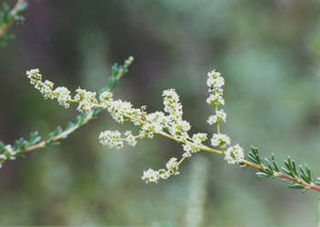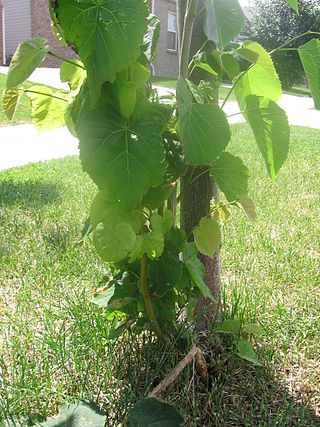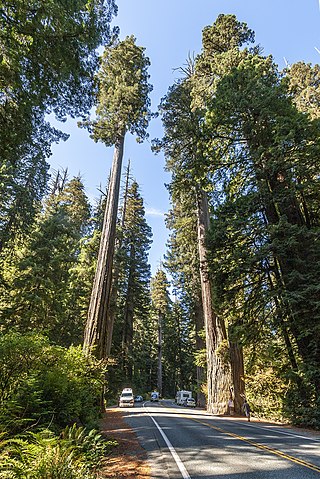Related Research Articles

Chaparral is a shrubland plant community found primarily in California, in southern Oregon and in the northern portion of the Baja California Peninsula in Mexico. It is shaped by a Mediterranean climate and infrequent, high-intensity crown fires.

Rooibos, or Aspalathus linearis, is a broom-like member of the plant family Fabaceae that grows in South Africa's fynbos biome.

A lignotuber is a woody swelling of the root crown possessed by some plants as a protection against destruction of the plant stem, such as by fire. Other woody plants may develop basal burls as a similar survival strategy, often as a response to coppicing or other environmental stressors. However, lignotubers are specifically part of the normal course of development of the plants that possess them, and often develop early on in growth. The crown contains buds from which new stems may sprout, as well as stores of starch that can support a period of growth in the absence of photosynthesis. The term "lignotuber" was coined in 1924 by Australian botanist Leslie R. Kerr.

Pioneer species are hardy species that are the first to colonize barren environments or previously biodiverse steady-state ecosystems that have been disrupted, such as by wildfire.

Vegetative reproduction is any form of asexual reproduction occurring in plants in which a new plant grows from a fragment or cutting of the parent plant or specialized reproductive structures, which are sometimes called vegetative propagules.

Pinus pinaster, the maritime pine or cluster pine, is a pine native to the south Atlantic Europe region and parts of the western Mediterranean. It is a hard, fast growing pine bearing small seeds with large wings.

Fire ecology is a scientific discipline concerned with the effects of fire on natural ecosystems. Many ecosystems, particularly prairie, savanna, chaparral and coniferous forests, have evolved with fire as an essential contributor to habitat vitality and renewal. Many plant species in fire-affected environments use fire to germinate, establish, or to reproduce. Wildfire suppression not only endangers these species, but also the animals that depend upon them.

Adenostoma fasciculatum, commonly known as chamise or greasewood, is a flowering plant native to California and Baja California. This shrub is one of the most widespread plants of the California chaparral ecoregion. Chamise produces a specialized lignotuber underground and at the base of the stem, known as a burl, that allow it to resprout after fire has off burned its stems. It is noted for its greasy, resinous foliage, and its status as one of California's most iconic chaparral shrubs.

Aesculus californica, commonly known as the California buckeye or California horse-chestnut, is a species of buckeye native to California and southwestern Oregon.

In ecology, a disturbance is a temporary change in environmental conditions that causes a pronounced change in an ecosystem. Disturbances often act quickly and with great effect, to alter the physical structure or arrangement of biotic and abiotic elements. A disturbance can also occur over a long period of time and can impact the biodiversity within an ecosystem.

Basal shoots, root sprouts, adventitious shoots, and suckers are words for various kinds of shoots that grow from adventitious buds on the base of a tree or shrub, or from adventitious buds on its roots. Shoots that grow from buds on the base of a tree or shrub are called basal shoots; these are distinguished from shoots that grow from adventitious buds on the roots of a tree or shrub, which may be called root sprouts or suckers. A plant that produces root sprouts or runners is described as surculose. Water sprouts produced by adventitious buds may occur on the above-ground stem, branches or both of trees and shrubs. Suckers are shoots arising underground from the roots some distance from the base of a tree or shrub.
The ecology of Banksia is the relationships and interactions among the plant genus Banksia and its environment. Banksia has a number of adaptations that have so far enabled the genus to survive despite dry, nutrient-poor soil, low rates of seed set, high rates of seed predation and low rates of seedling survival. These adaptations include proteoid roots and lignotubers; specialised floral structures that attract nectariferous animals and ensure effective pollen transfer; and the release of seed in response to bushfire.

Populus tremuloides is a deciduous tree native to cooler areas of North America, one of several species referred to by the common name aspen. It is commonly called quaking aspen, trembling aspen, American aspen, mountain or golden aspen, trembling poplar, white poplar, and popple, as well as others. The trees have tall trunks, up to 25 meters tall, with smooth pale bark, scarred with black. The glossy green leaves, dull beneath, become golden to yellow, rarely red, in autumn. The species often propagates through its roots to form large clonal groves originating from a shared root system. These roots are not rhizomes, as new growth develops from adventitious buds on the parent root system.

Astragalus nitidiflorus is a species of legume in the family Fabaceae. It is endemic to Cartagena, southeast of Spain. It was refound after about 100 years of extinction and "the reappearance of this species has awakened the interest of environmental managers because the reasons for its critical situation are unknown". In 2004, a group of 46 specimens were discovered in a protected area between Cartagena and Mazarrón and plans for the conservation of this species have been implemented. ISSR markers helped to find that Astragalus nitidiflorus has a low genetic diversity. "This species grows in shallow soil from metamorphic and volcanic rocks in between mountain and cultivated areas".

An epicormic shoot is a shoot growing from an epicormic bud, which lies underneath the bark of a trunk, stem, or branch of a plant.

Sequoia sempervirens is the sole living species of the genus Sequoia in the cypress family Cupressaceae. Common names include coast redwood, coastal redwood, and California redwood. It is an evergreen, long-lived, monoecious tree living 1,200–2,200 years or more. This species includes the tallest living trees on Earth, reaching up to 115.9 m (380.1 ft) in height and up to 8.9 m (29 ft) in diameter at breast height. These trees are also among the longest-living organisms on Earth. Before commercial logging and clearing began by the 1850s, this massive tree occurred naturally in an estimated 810,000 ha along much of coastal California and the southwestern corner of coastal Oregon within the United States.

Dalea foliosa, commonly called leafy prairie clover, is a species of flowering plant in the legume family (Fabaceae). It is an endangered species in the United States, where it occurs in three states: Illinois, Tennessee, and Alabama.

Resprouters are plant species that are able to survive fire by the activation of dormant vegetative buds to produce regrowth.

Fire adaptations are traits of plants and animals that help them survive wildfire or to use resources created by wildfire. These traits can help plants and animals increase their survival rates during a fire and/or reproduce offspring after a fire. Both plants and animals have multiple strategies for surviving and reproducing after fire. Plants in wildfire-prone ecosystems often survive through adaptations to their local fire regime. Such adaptations include physical protection against heat, increased growth after a fire event, and flammable materials that encourage fire and may eliminate competition.

Arctostaphylos glandulosa subsp. crassifolia is a rare perennial shrub, a subspecies of manzanita within the heather family commonly known as the Del Mar manzanita. It is narrowly endemic to the sandstone coastal terraces of San Diego County and northwestern Baja California. It is a burl-forming evergreen shrub typically found growing in a rambling habit on poor soils and hardpan. From December to February, white to pink urn-shaped flowers decorate its foliage, giving way to small fruits. It is listed as endangered and is threatened by land development, invasive species and modifications to the natural fire regime.
References
- Arthur W. Sampson and Arnold M. Schultz, Control of brush and undesirable trees
- William J. Bond and Jeremy J. Midgley (2003) The Evolutionary Ecology of Sprouting in Woody Plants, Int. J Plant Sci. 164(S3):S103–S114. 2003, University of Chicago.
- C. Michael Hogan. 2008. Aesculus californica, Globaltwitcher.com, ed. N. Stromberg